The Only Kettlebell Workout You Need: 3 Circuits Designed by Top Trainers

Verywell Fit
Medically reviewed by Kristin McGee, CPTMedically reviewed by Kristin McGee, CPT
Kettlebell workouts can be a fun, dynamic way to strengthen your muscles, get your heart pumping, and shake off some stress from everyday life. This type of strength and conditioning exercise centers around the use of a cannonball-shaped weight with a handle attached to it, known as a kettlebell. They are often performed in circuits or as part of high-intensity interval training (HIIT) routines, offering a challenging full-body workout.
Chris Ryan, CSCS, a personal trainer, explains that kettlebell workouts, which typically involve dynamic movements such as swings, presses, and lunges, are designed to target multiple muscle groups simultaneously, improving strength, endurance, flexibility, and cardiovascular fitness. “I love kettlebell workouts because they are highly versatile and can be adapted to suit individuals of varying fitness levels—from beginners to advanced athletes,” he says. “Kettlebell workouts are popular for their efficiency in building functional strength, promoting fat loss, and improving overall physical performance."
Here's what you need to know about kettlebell workouts, including how to incorporate them into your workout routine.
Benefits of a Kettlebell Workout
There are so many reasons to incorporate kettlebell workouts in your exercise regimen. Here are the key perks according to experts.
Takeaway
Improves strength: As a strength and conditioning exercise, you are engaging various muscle groups at the same time, including your legs, hips, core, back, and shoulders, says Ryan. “As you progress and increase the weight of the kettlebell, you continually challenge your muscles, leading to strength gains over time. This functional strength gained from kettlebell workouts improves performance in daily activities and sports.”
Enhances cardiovascular health: Because kettlebell workouts require significant endurance and stamina, you can expect to get your heart pumping, improving both aerobic and anaerobic conditioning, adds Ryan.
Increases stability and balance: Strong core muscles are essential for maintaining proper form and effectively controlling the kettlebell. Ryan explains that this helps improve overall stability and balance and enhances proprioception (awareness of body position).
Builds a time-efficient workout: If you’re looking to get a bang for your buck in terms of time, kettlebell workouts are a great option, says Ryan “Because they engage multiple muscle groups simultaneously and often involve high-intensity intervals, you can achieve significant results in strength, cardiovascular fitness, and calorie burn in relatively brief sessions. This makes kettlebell training ideal for individuals with busy schedules who seek effective workouts that maximize results in minimal time.”
Warm-Up
Before you get started, it's important to get your body ready for the movements. Here are some things you can do to prepare.
Light cardio: Light cardio, whether jogging in place, doing jumping jacks, or even cycling at a slow pace, can help increase your heart rate and blood flow. This helps prepare your body for the more intense exercises that will follow, explains Anthony D'Andrea, CPT, a certified personal trainer and functional kettlebell specialist.
Dynamic stretches: Dynamic stretches, like lunges, squats, and high knees, involve moving through a range of motion, which helps improve flexibility, mobility, and joint stability. Ryan explains that dynamic stretching primes the muscles and joints for the specific movements involved in kettlebell exercises and helps improve muscle elasticity and range of motion, reducing the risk of strains or pulls during the workout.
Kettlebell swings: Performing light kettlebell swings helps your body adapt to the movement mechanics before getting into your circuits. These swings also increase your heart rate, further contributing to the warm-up process.
Circuit 1
Once you're warmed up, you're ready to start your first circuit. During this circuit, you should perform three sets of 10 to 12 repetitions per exercise. Here's what to include.
Takeaway
Goblet squat
Single-arm row
Kettlebell press
Goblet Squat
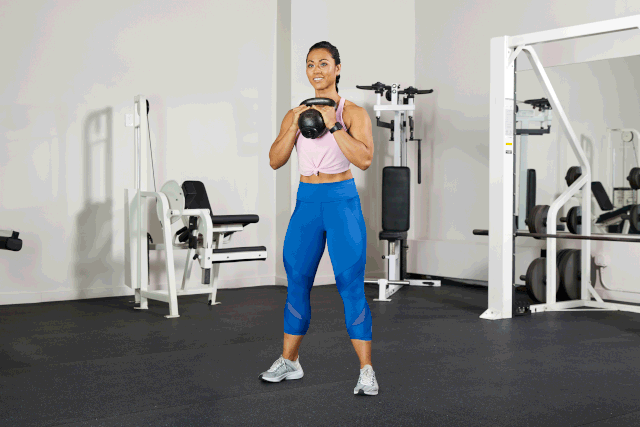
Verywell Fit
The goblet squat, the most classic kettlebell movement, targets the quadriceps, hamstrings, glutes, and core and also promotes posture and spinal alignment, says Ryan.
How to perform a goblet squat: Hold the kettlebell close to your chest, squat down, and push your hips back before returning to the starting position. Holding the kettlebell in front of your body counterbalances your weight, allowing you to keep proper form while squatting deeper.
Single-Arm Row
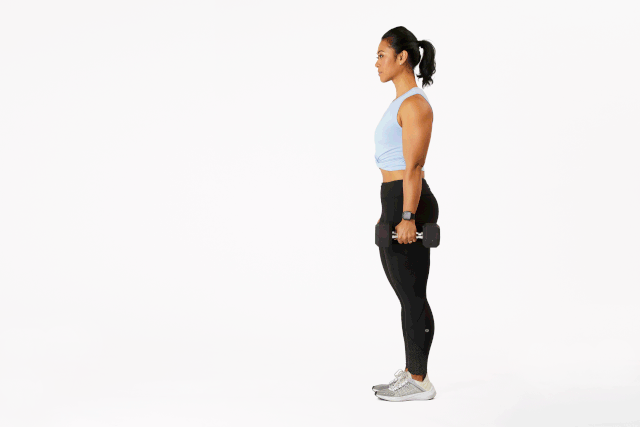
Verywell Fit
Ryan explains that the single-arm row targets the muscles in your upper back (the latissimus dorsi, rhomboids, and rear deltoids, as well as the biceps and forearm muscles) and helps balance out the pressing movements often performed in kettlebell workouts. This promotes better posture and shoulder health. Note that this image swaps a dumbbell for a kettlebell as a modification.
How to perform a single-arm row: Place one hand and knee on a bench or other stable surface, hold a kettlebell in the opposite hand, pull the kettlebell up toward your hip, keeping your elbow close to your body, and then lower it back down with control. Return to standing and repeat on the other side.
Kettlebell Press
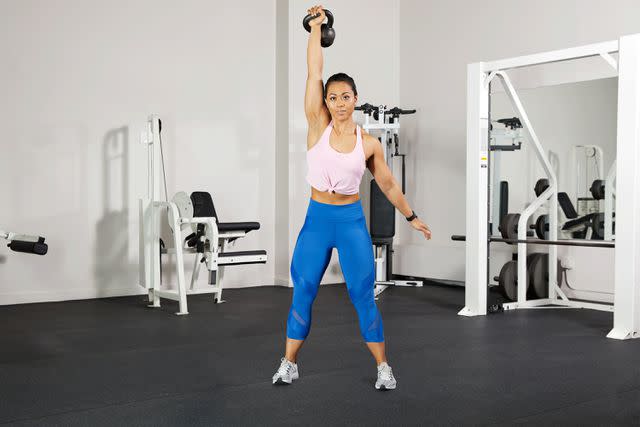
Verywell Fit
The kettlebell overhead press targets the shoulders, triceps, and stabilizing muscles of the core and upper back. “It's a compound movement that helps to develop upper body strength and stability," says Ryan. "Using a kettlebell for the press adds an element of instability compared to traditional barbell or dumbbell presses, engaging more muscles for balance and coordination.”
How to perform a kettlebell press: Start holding the kettlebell at shoulder height with your palm facing inward. Next, press the kettlebell overhead until your arm is fully extended before lowering it back down in a slow and controlled motion.
Circuit 2
During this circuit, you should perform three sets of 10 to 12 repetitions per side. Here's what to include.
Takeaway
Alternating renegade row
Bulgarian split squat
Lateral lunge with overhead press
Alternating Renegade Row
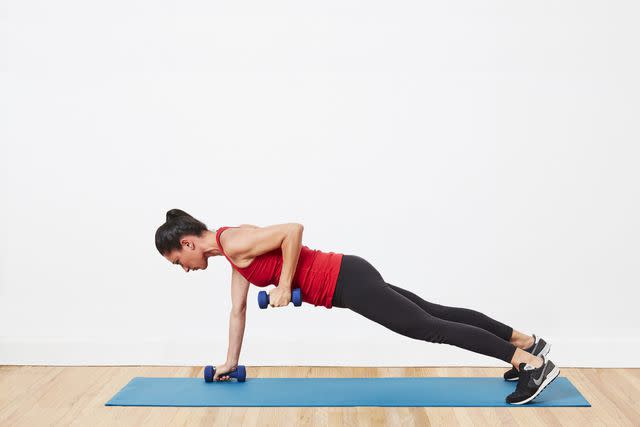
Verywell Fit
The alternating renegade row is a complex, compound movement that targets your back, shoulders, and core, enhancing strength and stability. Note that this image portrays the exercise with dumbbells as a modification.
How to perform an alternating renegade row: Start in a plank position with each hand gripping a kettlebell on the floor. Row one kettlebell up toward your hip while focusing on stabilizing with the opposite arm. Alternate sides while continuing to maintain a strong plank position.
Bulgarian Split Squat
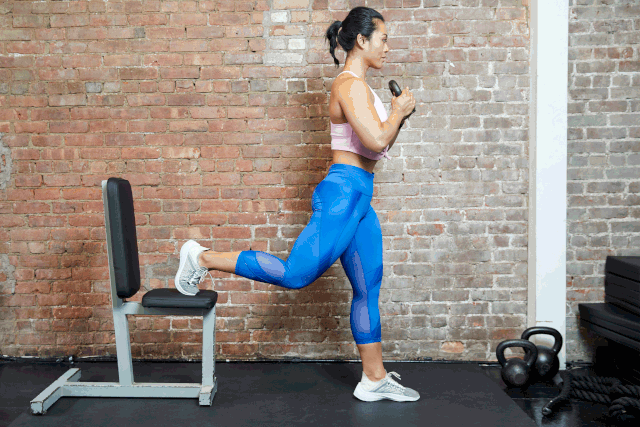
Verywell Fit
The Bulgarian split squat is a unilateral lower-body exercise that targets the quadriceps, hamstrings, glutes, and stabilizing muscles. “Elevating the back foot on a bench increases the range of motion and places more emphasis on the front leg, making it a highly effective exercise for building lower body strength and stability," says Ryan.
How to perform a Bulgarian split squat: Stand a few feet in front of a bench or a step. Place one foot on the bench or step and lower your body into a lunge position until your front thigh is parallel to the ground. Push back up to the starting position and repeat.
Lateral Lunge with Pull
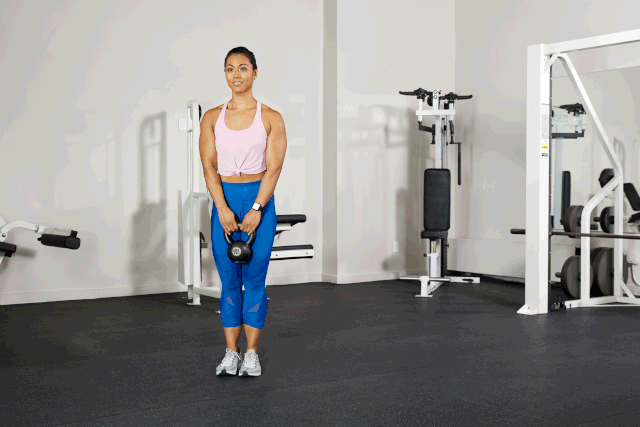
Verywell Fit
If you’re looking to work your lower and upper body simultaneously, this is a great exercise. “This exercise also engages the muscles responsible for lateral movement, which are often neglected in traditional forward-and-backward exercises,” says Ryan. The pull adds an additional challenge to the arms and core, making it a comprehensive full-body exercise.
How to perform a lateral lunge with pull: Start standing straight up, lunge to the right, and pull the kettlebell to your chest. Return to the starting position and repeat to the left.
Circuit 3
During this circuit, you should perform three sets of 15 to 20 repetitions per exercise. Here's what to include.
Takeaway
Swings
High knees with kettlebell
Russian twists with kettlebell
Swings
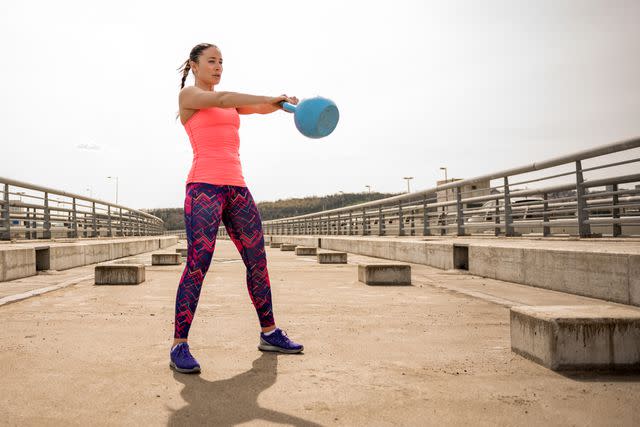
Getty Images / EXTREME-PHOTOGRAPHER
Kettlebell swings, the same ones that can be performed toward the end of a warm-up, are dynamic and explosive movements that target the posterior chain (glutes, hamstrings, and lower back), says Ryan. “Swings are a foundational kettlebell exercise that builds power, strength, and cardiovascular endurance."
How to perform swings: Stand with your feet shoulder-width apart while holding the kettlebell in front of you. Hinge at your hips and swing the kettlebell back between your legs before driving your hips forward to swing the kettlebell up to chest level or higher.
High Knees with Kettlebell
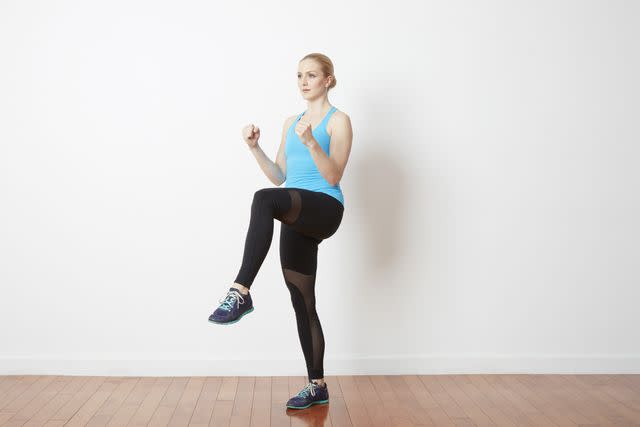
Verywell Fit
D'Andrea explains that this exercise elevates your heart rate and improves coordination. It mimics a running motion while simultaneously adding resistance. “It's like sprinting in place with added weight, challenging both strength and cardiovascular fitness." Note that this image portrays a modification of this exercise without the kettlebell.
How to perform high knees with a kettlebell: Start by holding the kettlebell in a tall position before jogging in place, driving your knees toward your chest as high as possible.
Russian Twists
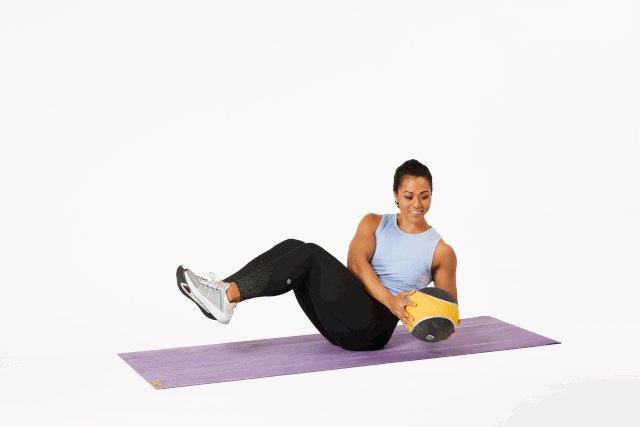
Verywell Fit
Russian twists are a core-strengthening exercise that targets your obliques, abs, and lower back muscles. You may modify this exercise by skipping the kettlebell or opting for a lower-weight dumbbell or medicine ball (as shown above).
How to perform a Russian twist: Start seated on the floor with your knees bent and feet lifted off the ground. Holding the kettlebell with both hands, lean back slightly, rotate your torso to one side, then to the other, while holding the kettlebell close to your body, instructs Ryan.
Cool-Down
When cooling down, you want to focus on improving your flexibility, reducing muscle tension, and encouraging relaxation so your heartbeat slows. Stretching your hamstrings, calves, quadriceps, triceps, and shoulders helps alleviate muscle tension by elongating the muscle fibers. It also promotes relaxation, aids in muscle recovery, and helps prevent injury by reducing the risk of sprains and strains, says Ryan.
Modification and Progression Options
When doing a kettlebell workout, it's important to make sure the exercises match your fitness level and challenge you. In the beginning, you may need to modify the movements to ensure you can do them properly without hurting yourself or compromising your form. Then, as you get used to kettlebell exercises, you may have to increase the difficulty to continue to challenge yourself. Here are some things to consider.
Lighter Weights for Beginners
If you’re new to kettlebell workouts, start with lighter weights or even use your body weight as a substitute so that you can focus more on form and technique, says Ryan. “Using lighter weights allows beginners to build strength gradually while reducing the risk of injury and also helps to improve coordination and neuromuscular control."
Single-Arm Exercises
If you struggle with bilateral movements or have muscular imbalances, Ryan recommends performing single-arm kettlebell exercises. “Single-arm variations, such as single-arm swings, single-arm rows, or single-arm presses, allow for greater focus on each side of the body and help improve balance and symmetry."
Supervised Training
Consider enlisting the help of a qualified fitness professional who can provide personalized modifications and guidance on progression to ensure safe and effective workouts. They also can provide feedback on form and give suggestions on how to tailor the workout to your needs.
Increase Difficulty
D'Andrea explains that gradually increasing the weight and number of sets over time will help stimulate muscle growth and strength gains. He recommends starting with a weight that feels challenging but still allows proper form, then gradually increasing the weight as you become stronger and more proficient in the exercises.
“It's like adding bricks to a wall one at a time, gradually building strength and resilience,” he says. “Never be afraid to grab a lighter weight when practicing new movements.”
Safety Concerns
As with any exercise, you must incorporate safety techniques to prevent injury. “Maintaining a strong grip, stable core, and proper alignment will ensure a safe and efficient movement execution," says D'Andrea. "If you’re ever in doubt, visualize the movement you’re trying to do, decrease the weight, and practice it with low intensity.”
Bottom Line
Mastering the art of kettlebell workouts can unlock a slew of fitness benefits, from improved strength and endurance to enhanced mobility and agility. By incorporating dynamic movements into your routine, you engage multiple muscle groups simultaneously, promoting efficient calorie burn and functional strength development.
Before embarking on this type of workout experience, though, it’s wise to make sure you’re following the proper form to maximize effectiveness and minimize injury. Also, consider exploring other kettlebell exercises and variations to create a well-rounded workout program.
Read the original article on Verywell Fitness.

